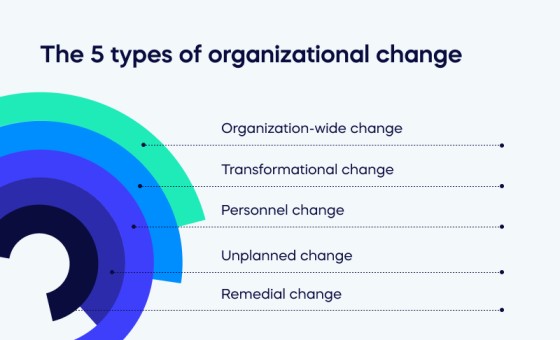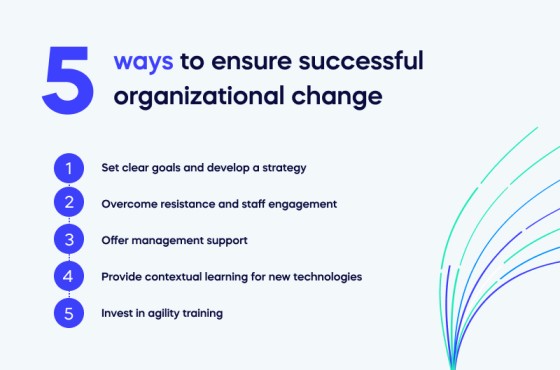Change is a fact of life.
Think about the seasons; summer fades into autumn every year around this time. The temperature drops, and the leaves change colors, eventually falling from the trees.
But not all types of organizational change are so routine or graceful. Change might be as inevitable as the shifting weather — but that doesn’t mean there aren’t ways to ensure a successful organizational change in your company via your human resources department.
However, research shows that half of change initiatives fail and only 34% succeed. This makes it essential to ensure you don’t waste resources so you can become part of the successful minority for change efforts.
To help you understand the basics and significance of organizational change, we will explore the following topics:
- What is organizational change management?
- Why is organizational change important for an organization
- The 5 types of organizational change
- 5 ways to ensure successful organizational change
What is organizational change?
Organizational change is when a business significantly changes how it operates, like its culture, technology, or business processes. These changes can create challenges for staff, as it is human nature to resist change.
Why is organizational change important for an organization?
“Organizational change breathes life back into an organization, allowing it to serve users better and grow revenue within a thriving workplace.”

Dr Jess Tayel, Change Adoption Advisor and Consultant
In today’s dynamic world, technological change is a fact of life and essential for survival. New organizational developments and priorities happen quickly, thanks to COVID-19 & the digital transformation revolution helped along by ChatGPT and other generative AI tools.
Change is vital as it must cause disruption, but managing it is crucial to the outcome and how much value it provides. Manage it well, and changes will be positive and stick.
Organizational change implemented correctly will improve productivity among your employees as it boosts sales success, which is essential for business sustainability.
The 5 types of organizational change

With organizational change strategies, companies can avoid stagnation while minimizing disruption, whichever business models are in play.
The first step is understanding what change management models exist and determining what best suits your company or team for your corporate culture.
Let’s look at five types of organizational change companies undergo.
1. Organization-wide change
Organization-wide change is a large-scale business transformation that affects the entire company. This action could include restructuring leadership, human resource management, adding a new policy, or introducing a new enterprise technology.
Every single employee will feel such large-scale change. However, as the dust settles, you can see improvements to the organizational structure.
Organizational change can be a strong indicator of understanding how long-held policies have become outdated or reflect a company’s transforming identity.
Harvard Business Review Analytics Services published their evaluation of The State of Digital Adoption 2021, further showing the effects of proper implementation and adoption on the success of the complete organizational digital transformation.
2. Transformational change
Transformational change explicitly targets a company’s organizational strategy. Companies best suited to withstand rapid change in their industry are agile, adaptable, and prepared to transform their game plans when needed.
Strategies to guide transformational change must account for the current situation and the company’s direction. Cultural trends, social climate, and technological progress are some of the many factors leaders must consider.
However, given the rapid pace at which digital technology evolves, companies will be better positioned to succeed if they incorporate digital adoption platforms into their transformation strategies.
3. Personnel change
Personnel change happens when a company experiences hyper-growth or layoffs. Each type of organizational change can significantly reduce voluntary employee turnover and improved retention, so effective organizational change management is required to avoid these outcomes.
The threat of layoffs evokes fear and anxiety among staff members, and leaders should expect that employee morale will suffer. Nevertheless, the company must move forward, and companies must treat staff with understanding and compassion.
If you handle personnel changes poorly, chaos and inefficiencies will delay essential growth.
4. Unplanned change
Unplanned change is often a necessary action following unexpected events. While you cannot predict unanticipated change, you can prepare for it across your organization.
In 2022, central and Eastern US states saw a sudden cold weather event, causing millions of dollars of damage and creating challenges for residents.
Companies also experience unplanned changes, like when a CEO suddenly leaves the company or a security breach occurs. When this happens chaos and disruption can ensue.
By setting basic organizational change strategies to prepare for these situations, organizations can minimize these unplanned risks and emerge more adaptable and resilient following robust agility training.
Such training can also strengthen the organizational culture to deal successfully with unplanned change.
5. Remedial change
A change leader may implement remedial changes when they identify a need to address deficiencies or poor company performance as part of a change effort.
For example, financial distress is usually due to lackluster performance and will require remedial change. Other common examples include introducing an employee training program, rolling out new software, or creating a position to fix a pain point.
Other types of corrective action could include reviewing strategies that may have been in place for years but are no longer profitable—issues stemming from leadership.
Or, for example, a newly appointed CEO who turns out to be a poor fit for the company might also call for remedial change.
Although you can tailor remedial change efforts to the specific problem on hand, they still require effective organizational change strategies to be effective.
5 ways to ensure successful organizational change

Organizational change has many clear benefits but can lead to misalignment and company-wide confusion without proper implementation.
To execute organizational change with glowing results, take note of these five ways to ensure its success.
1. Set clear goals and develop a strategy
Organizational change often transcends multiple departments and job functions. Various stakeholders are involved to guarantee their interests are heard and met.
To achieve successful organizational change, you must communicate and define goals and a digital strategy for reaching them. After all, how can you measure success if you don’t know what you’re aiming for?
A strategy helps determine the vision for what the company should look like after the change. It is the role of management to develop that vision by listening to the feelings and opinions of those affected.
Doing so encourages buy-in across the company and ensures your organization carries out the strategy as intended.
2. Overcome resistance and staff engagement
Organizational change can often be difficult, especially if your employees don’t see anything wrong with the status quo. To them, the change may appear disruptive at best, giving them reasons to resist change.
There will be new technologies to learn and platforms to navigate. Worse still, some employees may feel threatened if the initiated change automates many of their existing tasks.
Communication will be vital to getting your team on board. Survey opinions on the status quo and the proposed changes in the planning stages; they will feel included in the process, fostering a feeling of buy-in.
Explaining to your employees why these changes are necessary and will improve their day-to-day may also allay fears and reduce resistance.
3. Offer management support
For organizational change to be successful, it must be adopted across the business, from C-level down to managers. The CEO may have a vision for the direction of the change management, but it will be up to the rest of the business to execute it.
That’s why sharing that vision is essential so that others know their role in bringing it to fruition and their responsibilities after the changes.
Management support can be in the form of documenting feedback throughout the process, updating employees on progress and next steps and encouraging open lines of communication. All of these things will help your employees navigate their way through organizational change and even perform better.
4. Provide contextual learning for new technologies
It is inevitable that with any organizational change, there will be new tools to learn and understand. Learning is an ongoing journey and requires employers to provide contextual learning techniques.
Contextual learning, like a digital adoption platform, helps employees by personalizing their training experience.
Using sophisticated algorithms and correlating data on factors such as their level of seniority, job function, and previous actions, tailor training to the individuals’ needs.
Doing so comes in the form of pop-ups prompting the user with actions leading them to complete each step while also providing deep insights.
5. Invest in agility training
Organizational agility refers to reacting quickly to business operations, strategy, and even culture changes. However, agility is not innate within an organization; staff must learn it.
Agility can take different forms, but there are three main steps to focus on when developing agility training.
- Foster change management skills: These can be individual skills, such as personal resilience and organization, to more company-wide skills, like forcing clarity, networking, and coaching.
- Train your team in productive time management: Knowing how to evaluate what is essential versus urgent and how to prioritize tasks is crucial. Employees will have the skills to tackle changes within the organization or their daily jobs.
- Offer continual learning and development: Such information must be acclimated when organizational changes occur.
Proper agility training enables your business to pivot when the need arises. Organizational change will become just another task as opposed to an insurmountable challenge. This step is also essential for organizational health.
Use the 5 types of change to support your staff
Change is inevitable and can be a positive milestone for any organization with proper engagement. Still, it is essential to understand the five times of change to navigate periods of growth.
Allow teams to express their opinions and build upon ideas that address the organization’s current challenges. Leadership should set clear objectives that leverage these five types of change when approaching changes within a company.
Take action today and use your understanding and practical use of change to support your staff better!

